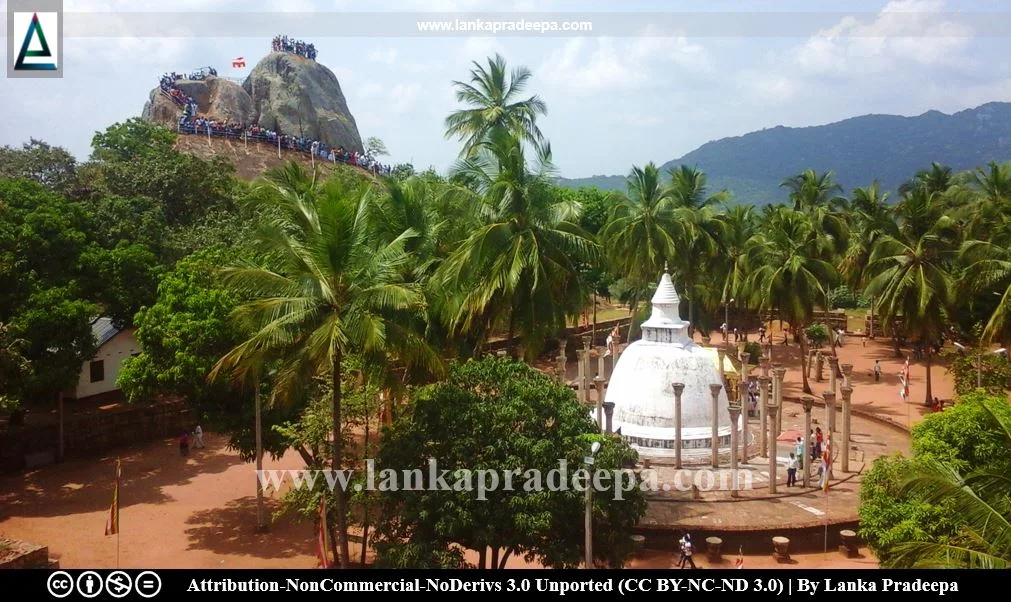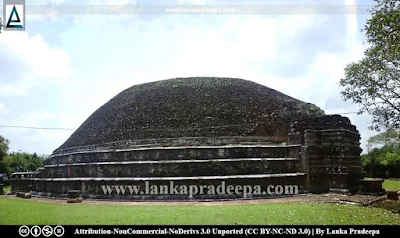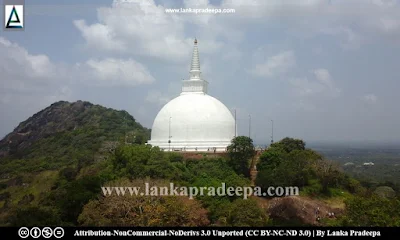
Mihintale (ancient Cetiyapabbata, Seygiri or Segiri Vihara) is a Buddhist monastery site situated in Anuradhapura District, Sri Lanka.
Mihintale Rock & the name
Mihintale rock has been identified with ancient Missaka-pabbata (Missakapawwa), called afterwards
Cetiya-pabbata/Cetiyagiri (Sinhala: Seygiri or Segiri) and Ambatthala (Wickremasinghe, 1912). The
name Cetiyapabbata means the "Mountain of Stupas" and it has come into parlance because of the large number of Stupas that have been built at various levels of the rock
(Nicholas, 1963; Wikramagamage, 2004). Mihintale is said to be the only
monastery having the largest number of Stupas in the country
(Wikramagamage, 2004).
Mihintale is the present name used to identify this site. It roughly means the "Plateau of Mahinda" and is said to have been derived from the name of Arhat Mahinda Thera (Jayasuriya, 2016). A Later Brahmi Rock Inscription discovered from Mihintale has the name "Mihidala" which is supposed to be the ancient form of the present name (Paranavitana, 2001).
Mihintale rock is 309.73 m in height and the extent of the monastic site is about 182.25 hectares [(450.34 acres) Wikramagamage, 2004]. Near this place are several historic sites such as Eth Vehera, Anaikuti-Kanda and Rajagirilena-Kanda. Some pre-historic artefacts are said to have been discovered in a few caves of these sites (Wikramagamage, 2004).
History
The cradle of the Sinhala Buddhist civilization
According to chronicles, Mihintale is the place where the Indian missionaries headed by Arhat Mahinda Thera, the son of Indian Emperor Ashoka (c.268-232 B.C.) met King Devanampiyatissa (247-207 B.C.) in the 3rd century B.C. (Jayasuriya, 2016; Nicholas, 1963; Wikramagamage, 2004). As a result of this meeting, the king embraced Buddhism and established Buddhism as the religion of the Sinhalese people (Jayasuriya, 2016; Nicholas, 1963). Therefore, Mihintale is considered the fountain of Buddhist culture in Sri Lanka as well as the cradle of the Sinhala Buddhist civilization.
After embracing Buddhism, King Devanampiyatissa established the first monastery at Mihintale and presented it to Arhat Mahinda Thera (Nicholas, 1963; Wikramagamage, 2004). He refurbished sixty-eight caves (see Ataseta Len) and bestowed them to the community of monks (Wikramagamage, 2004). It is said that Arhat Mahinda Thera resided in one of them and that cave is presently known as Mihindu Guhava [(Theranambattha-Lena) Nicholas, 1963; Wikramagamage, 2004]. Also, a monk named Lomasa Naga lived later in one of these caves called Piyanguguha
and another cave was known as Rajagirilena during the reign of King
Saddhatissa [(137-119 B.C.) Nicholas, 1963]. According to Mahavamsa, King Devanampiyatissa planted a sapling of the Bodhi tree at Mihintale and completed the repairs of its buildings (Nicholas, 1963; Wickremasinghe, 1912).
After the death of Arhant Mahinda Thera (in the 8th year of the reign of King Uttiya), his ashes were enshrined in a Stupa by King Uttiya (Nicholas, 1963). The ruined Stupa (see Mihinduseya at Mihintale) near the Mihintale Maha Seya is believed to be that monument (Nicholas, 1963). The Mihinduseya at Rajagala is believed to be another Stupa built to commemorate Arhat Mahinda Thera.
Shortly after the reign of King Devanampiyatissa, the Kantaka Cetiya was built at Mihintale (Wikramagamage, 2004). King Lanjatissa (119-109 A.D.) encased with stone a Stupa and an Uposatha Hall with a stone Thupa (Sila Cetiya) in front of it was added to the temple by King Kutakannatissa [(42-20 B.C.) Nicholas, 1963; Wickremasinghe, 1912]. King Bhatikabhaya (20 B.C.-9 A.D.) made donations to the monks and King Mahadathika Mahanaga (9-21 A.D.) erected a great Stupa (see Mihintale Maha Seya) on Ambatthala and held a great festival which is later known as the "Giribhanda festival" (Wickremasinghe, 1912). King Kanijanutissa (31-34 A.D.) settled a problem that arose in the temple, imprisoned sixty monks who were engaged in a conspiracy against him and
finally flung them into the caves called
Kanira [(see Ataseta Len) Nicholas, 1963; Wickremasinghe, 1912]. King Vasabha (67-111 A.D.) built 10 Stupas and illuminated a thousand lamps at Mihintale mountain (Nicholas, 1963). King Kanitthatissa (165-193 A.D.) built a Cetiyaghara at Ambatthala (see Ambastala Stupa Vatadage) which was afterwards repaired by King Gotabhaya [(254-267 A.D.) Nicholas, 1963; Wickremasinghe, 1912]. The tank named Kalamattika Wewa was granted for the use of Mihintale by King Jetthatissa [(263-275 A.D.) Nicholas, 1963; Wickremasinghe, 1912]. King Mahasena (277-304 A.D.) assigned Mihintale to the Abhayagiriya Monastery in his reign and a procession conveying a golden statue of Arhat Mahinda Thera was held by King Sirimeghavanna [(304-332 A.D.) Wikramagamage, 2004; Wickremasinghe, 1912].
In the 5th century A.D., the Mihintale was passed into the control of
the Mahayana fraternity of Abhayagiriya Monastery (Nicholas, 1963) Fa-Hsien, a Chinese monk who stayed in Sri
Lanka from 411 to 413 A.D., reveals in his notes that there were about 2,000 resident Buddhist
monks in Mihintale (Nicholas, 1963;
Wikramagamage, 2004). King Dhatusena (455-473 A.D.) is said to have rebuilt the Ambatthala Vihara and
conferred it on the Dhammaruci sect of Abhayagiriya Monastery
(Nicholas, 1963; Wickremasinghe, 1912). King Aggabodhi I (564-598 A.D.) built a bath named Nagasondi (see Naga Pokuna) at Mihintale and King Aggabodhi III (624-640 A.D.) dedicated the village Ambillapadara to the temple (Wickremasinghe, 1912). King Aggabodhi V (726-732 A.D.) repaired the dilapidated structures of the temple and the queen of King Udaya I (797-801 A.D.), built Kattaka Cetiya at Mihintale (Nicholas, 1963). King Sena II (853-887 A.D.) established a Hospital at Mihintale (Nicholas, 1963; Wickremasinghe, 1912). The inscription of King Kassapa V (929-939 A.D) near "Stone Canopy" at Anuradhapura reveals that both Mihintale and Ath Vehera then belonged to Kaparamula Fraternity of Abhayagiri Viharaya (Wickremasinghe, 1912).
During the Polonnaruwa Period King Parakramabahu I (1153-1186 A.D.) renovated 64 Stupas at Mihintale (Nicholas, 1963).
Inscriptions
A large number of inscriptions (caves, rock, slabs, pillars etc.) ranging from 3rd century B.C. to 10th century A.D. have been discovered from the premises of Mihintale monastery as well as from the areas located vicinity such as Rajagiri-Kanda, Anaikuti-Kanda etc. (Dias, 1991; Paranavitana, 1970; Paranavitana, 1983; Paranavitana, 2001; Ranawella, 2001; Ranawella, 2004; Ranawella, 2005). Prof. Paranavitana, in his publication in 1970, has read 58 Early Brahmi Inscriptions in Mihintale, 9 in Rajagirillena-kanda, 7 in Anaikuti-kanda and 1 on a stone on the bund of the Mihintale tank (Paranavitana, 1970). He has further read 6 later Brahmi inscriptions in Mihintale and 2 in Rajagirilena-Kanda (Paranavitana, 1970).
Mihintale early-Brahmi inscription of princess (Abi)Tissa
Period: 210-200 B.C. Script: Early Brahmi Language: Old Sinhala
Transcript: (1) Gamani-Uti-maharajhaha jhita Abi-Ti]shaya lene dasha-dishsha sagaye dine (symbols) (2) mata-pitasha ataya
Translation: (1) The cave of princess (Abi)Tissa, daughter of the great king Gamani-Uttiya, is given to the Sangha of the ten directions, (2) for the benefits of the mother and the father.
Note: The name Uti is, without doubt, the name occurring in the chronicles as Uttiya. In the list of kings given in the Dipavamsa and Mahavamsa, there is only one sovereign of this name; that was the younger brother of Devanampiyatissa.
Citation: Paranavitana, 1970. pp.lii,3.
Among the number of later-Brahmi inscriptions in Mihintale, one is considered special as it contains the name of Arhat Mahinda Thera as well as the names of three of his companions namely Itthiya, Uttiya, and Badrasala (Paranavitana, 1983). However, as mentioned in the chronicles, one of the four companions of Arhat Mahinda Thera, Sambhala, does not find mentioned in this inscription (Paranavitana, 1983). This is also the earliest document in the country where a reference to coconut grooves has been made (Paranavitana, 1983).
Mihintale rock inscription of Mahadatika Mahanaga (9-21 A.D.)
Period: 1st century A.D. Script: Later-Brahmi Language: Old Sinhala
Content: This inscription lists the tanks, canals, villages, highlands, coconut lands etc. donated for the use of the monks of Segira (Mihintale) Viharaya. Also, it records the donations made for the maintenance of the images of the Arhat Mahinda Thera, and Reverends Itthiya, Uttiya, and Bhadrasala Theras.Three inscriptions belonging to the 6-7th centuries A.D. were found on a slab on the pavement of the Ambasthala Stupa at Mihintale (Dias, 1991).
Mihintale Ambasthala Stupa inscription
Period: 6-7th century A.D. Script: Later-Brahmi Language: Old Sinhala
Transcript: (1) [Jayapa....pura ma]..... (2) vaharala vata katu......>>Translation:......gave for the purpose of maintaining the compulsory service at the monastery. May the merit be achieved by all beings.
Citation: Dias, 1991.An inscribed rectangular stone pillar of King Udaya II (887-898 A.D.) was found near the ancient Hospital at Mihintale in 1952 (Ranawella, 2001). It helped to confirm the identity of the site of the Segiriya hospital (Ranawella, 2001). Another inscription of King Kassapa IV (909-914 A.D.) that was discovered at the same site enabled scholars to identify it as a hospital (Ranawella, 2001).
Mihintale fragmentary pillar inscription of Udaya II (887-898 A.D.)
Period: 9th century A.D. Script: Medieval Sinhala Language: Medieval Sinhala
Content:
This inscription has been issued to register certain immunities granted by the king in respect of the land on which the Mihintale hospital (Segiriya ved-hala) had been located.Two slab inscriptions of Mahinda IV have been erected in a ruined building at Mihintale. These two inscriptions have been inscribed on the orders of King Mahinda IV
(956-972 A.D.) to provide information on the administration and inner
life of the Mihintale monastery. They reveal the rules and
regulations pertaining to the monk community, the intervention of the
State, the wages and allowances for the employees of the temple as well
as the information regarding the work involved with the temple, the
relic house, and special monastic buildings.
Monuments
The existing ruins at Mihintale indicate that the monastery was in an active state from the 3rd century B.C. to the 14th century A.D. (Wikramagamage, 2004). These ruins comprise a network of monasteries, caves, religious monuments and waterworks. Some of the important monuments belonging to the monastery are listed below;
The main flight of steps: The main flight of steps that leads the devotees to the Ambastala plain is located on the western slope of the mountain. It has 1840 stone steps arranged in three flights (Jayasuriya, 2016; Wickremasinghe, 1912). Shaded by temple trees on either side, this is perhaps the widest flight of steps in the country (Jayasuriya, 2016).
Kantaka Cetiya: This Stupa is believed to have been constructed during or soon after the
reign of King Devanampiyatissa (Nicholas, 1963).
According to Mahawamsa, Devanampiyatissa had refurbished sixty-eight
caves in the neighbourhood of the Kantaka Cetiya for the use of the monks
headed by Arhat Mahinda.
Ambastala Stupa & Vatadage: This Stupa has been built on the highest point of the Ambastala plain. As a belief of the people, this place has been hallowed by the Buddha on one of his visits to the island (Jayasuriya, 2016). A Stupa named Sela Cetiya is
said to have been erected at this place by King Mahadathika Mahanaga
[(9-21 A.D.) Wikramagamage, 2004]. The Vatadage (circular Stupa shrine)
was constructed around the Stupa by King Kanittha Tissa [(165-193 A.D.)
Wikramagamage, 2004].
Maha Thupa: This is the largest Stupa in Mihintale. Built by King Mahadatika Mahanaga (9-21 A.D.), it is believed that the Urnaromadhatu
of the Buddha (the rounded hair in the middle of the forehead of the
Buddha) has been enshrined in this Stupa (Wikramagamage, 2004). The Stupa has been referred to as Ambulu Dagoba in Pujavaliya as well as in the Lithic Records of Mahinda IV (Wickremasinghe, 1912).
Mihindu Seya: This Stupa has been built in memory of Arhat Mahinda Thera (Jayasuriya, 2016). It is said that King Uttiya, the younger brother of King Devanampiyatissa (247-207 B.C.), built a Stupa on the summit of the Mihintale mountain by enshrining a part of the relic of Arhat Mahinda Thera (Nicholas, 1963). The old stupa which is found to the west of the Maha Seya has been identified as that Stupa which is mentioned in the chronicle Mahawamsa (Nicholas, 1963)
Giribhanda Seya:
A Stupa exposed by an excavation done in 1951. Although the builder of it is not known, it has been dated by scholars to the 8th century A.D.
The relic chamber (with fragments of paintings) that was recovered from the stupa is presently being exhibited in the Mihintale museum.
Indikatuseya: Indikatuseya
Stupa has been built on a brick platform about 5 ft. 6 in. tall
(Jayasuriya, 2016). Several copper plates containing quotations from
Mahayana texts in Sinhala letters of the 8-9th centuries A.D. have been
recovered from this Stupa during the conservation works that commenced in
1923 (Jayasuriya, 2016).
Katuseya: It is believed that the smithy implements and the tools used in the
construction work of the Mihintale complex have been enshrined in this
Stupa. According to the remaining architectural features, it has been
found that this was a Stupa-centered monastic complex that belonged
to the Mahayana tradition of the Anuradhapura Period.
Ath Vehera: A brick-built Stupa constructed on a terrace 14 m in diameter (Wikramagamage, 2004). Renovations were done in 1984
(Wikramagamage, 2004).
Mihindu Guhawa: This rock cave is supposed to have been used by Arhat Mahinda Thera (Jayasuriya, 2016). A part of the cave (which measures 2.28 x 1.06 m) has been polished to suit human habitation and that is believed to have been used as a bed (Wikramagamage, 2004).
Monk's Hospital: This hospital has been assigned to King Sena II (853-887 A.D.) and a 9th-century inscription at a ruined building located near the entrance to the Vihara refers to it as the Segiri Hospital (Jayasuriya, 2016; Nicholas, 1963). Metal surgical instruments and a medicinal canoe have been found at this site (Jayasuriya, 2016).
The alms-hall: This building has been identified as the place where the daily alms were provided for the monks who lived in Mihintale.
Sannipata Salawa: This ruined building has been identified as the
assembly hall of the Mihintale monastery where monks assembled to
discuss matters of common interests pertaining to the monastic life.
Aradhana Gala: The
Aradhana Gala rock is believed to be the spot on which the Arhat
Mahinda Thera alighted when he came through the air (Jayasuriya, 2016).
Kaludiya Pokuna: Kaludiya
Pokuna means the "Blackwater pond". It is located at the foot of the southern incline of Mihintale mountain. The remains of an ancient monastery complex are found around this pond. These ruins have been dated by scholars to the 10th century A.D. (Jayasuriya, 2016).
Naga Pokuna: The history of the Naga Pokuna runs back to the time of the arrival of
Arhat Mahinda Thera in Sri Lanka (Wikramagamage, 2004). It is mentioned in chronicles that the pond named Nagacatukka was used as a bathing tank by Mahinda Thera and the monks of the Vihara (Nicholas, 1963).
Chronicles further record that King Aggabodhi I (575-608 A.D.) had built
a bath at Cetiyagiri (modern Mihintale) by the name Nagasondi and
supplied it with a continual stream of water (Wickremasinghe, 1912).
Sinha Pokuna: This pond has been given its name since there is a statue of a lion standing with two legs. The lion figure has been made on the outer wall of the lower terrace of the pond. The water is discharged through the mouth of the lion making a spout. This was used to collect water for the use of Buddhist monks. The water for the pond had been supplied from the Naga Pokuna through a tunnel.
Archaeological Museum
A small site museum of the Archaeological Department has been established on the
premises of the Mihintale monastery. The museum is used to exhibit antiquities
recovered from the temple.
A protected site
The Ambastala Stupa, inscriptions, Mahaseya Stupa, Sela-cetiya, Naga Pokuna pond and other two Stupas situated in Mihintale monastery in Mihintale village in the Divisional Secretary’s
Division of Mihintale are archaeological
protected monuments, declared by a government gazette notification
published on 26 September 1941.
References
1) Dias, M., 1991. Epigraphical notes (Nos 1 -18). Colombo: Department of Archaeology. pp.15,19,85,90.
2) Jayasuriya, E., 2016. A guide to the Cultural Triangle of Sri Lanka. Central Cultural Fund. ISBN: 978-955-613-312-7. pp.58-62.
3) Nicholas, C. W., 1963. Historical topography of ancient and medieval
Ceylon. Journal of the Ceylon Branch of the Royal Asiatic Society, New
Series (Vol VI). Special Number: Colombo. Royal Asiatic Society (Ceylon
Branch). pp.162-166.
4) Paranavitana, S., 1970. Inscription of Ceylon (Vol. I). Department of Archaeology Ceylon. pp.lii,1-6,87.
5) Paranavitana, S., 1983. Inscriptions of Ceylon: Vol. II. Part I. Department of Archaeology, Sri Lanka. pp.26-27,30-34,37-39.
6) Paranavitana, S., 2001 (Edited by Dias, M.). Inscriptions of Ceylon: Vol. II. Part II. Archaeological Survey Department, Sri Lanka. pp.206-207,224-225,227-228.
7) Ranawella, S., 2001. Inscription of Ceylon. Volume V, Part I. Department of Archaeology. ISBN: 955-9159-21-6. pp.26-29,34-37,102-103,249.
8) Ranawella, G.S., 2004. Inscription of Ceylon: Containing pillar inscriptions and slab inscriptions from 924 AD to 1017. Volume V, Part
II. Department of Archaeology. pp.272-285.
9) Ranawella, S., 2005. Inscription of Ceylon. Volume V, Part
III. Department of Archaeology. ISBN: 955-91-59-57-7. pp.4-5,8-9,144,162.
10) Seneviratna, A., 1994. Ancient Anuradhapura: the monastic city. Archaeological Survey Department. p.236.
11) The government gazette notification. No: 8796. 26 September 1941.
12) Wikramagamage, C., 2004. Heritage of Rajarata: Major natural, cultural and historic sites. Colombo. Central Bank of Sri Lanka. pp.157-174.
13) Wickremasinghe, D.M.D.Z., 1912. Epigraphia Zeylanica: Being lithic and other inscription of Ceylon (Vol. I). London. Archaeological
Survey of Ceylon. pp.75-113.
Location Map
This page was last updated on 8 January 2023






